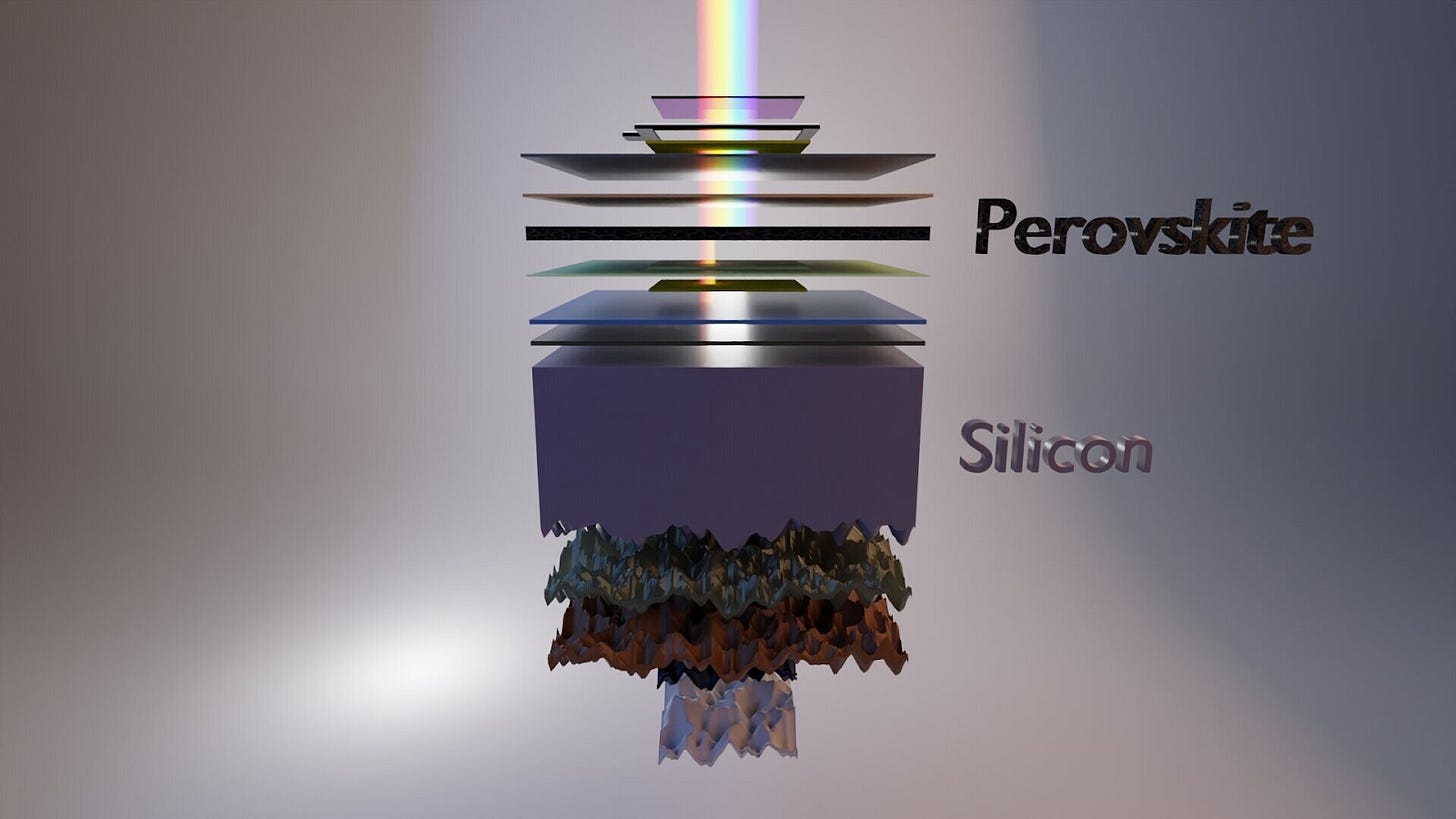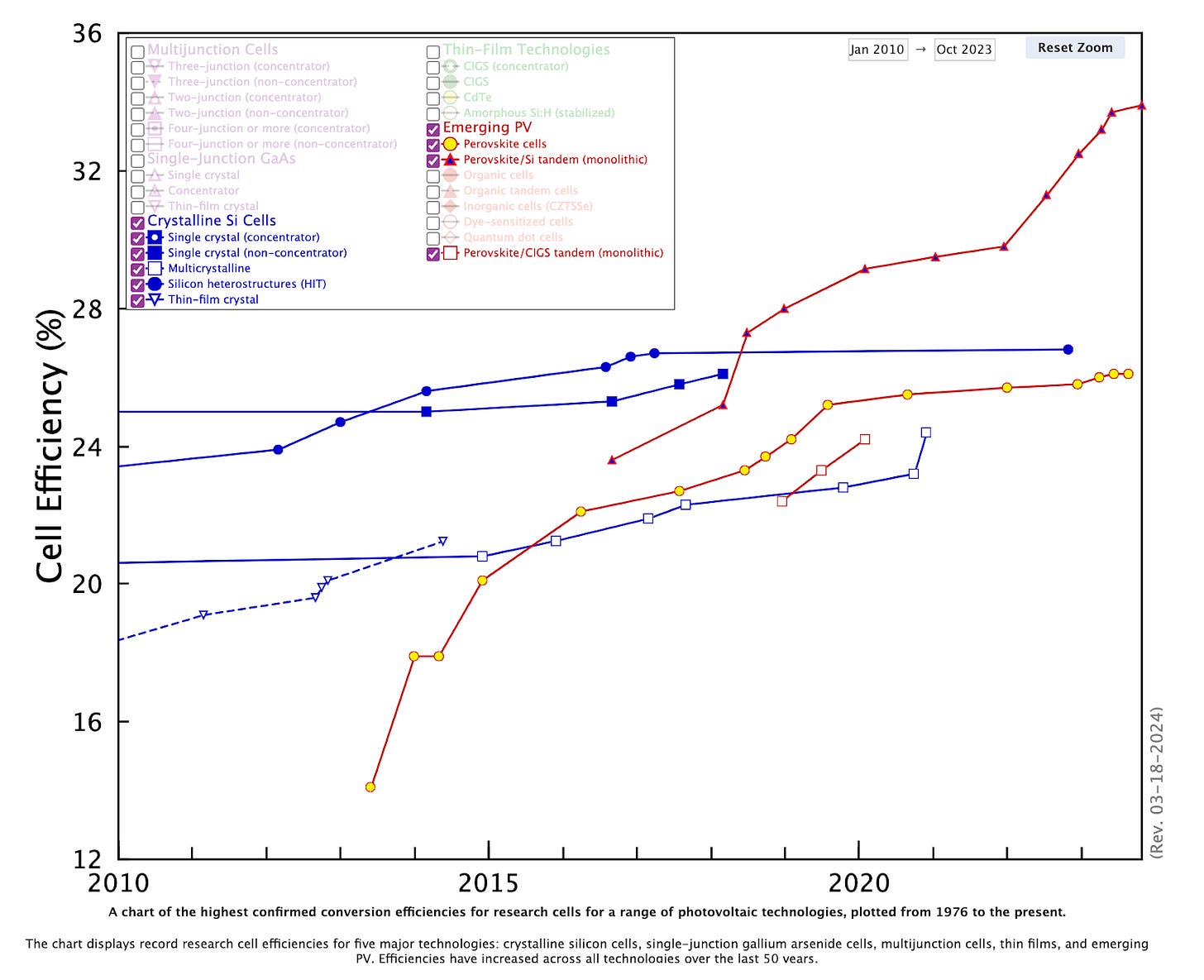Tandem partners for the solar spectrum
The promises and challenges of Perovskite-Silicon Tandem Solar Cells (PSTSCs)
Solar PV is widely recognized as one of the most crucial tools in combating climate change. With renewables set to contribute 80% of new power capacity by 2030 in the stated policies scenario, solar PV is projected to alone account for more than half of this, according to the International Energy Agency.1
Supported by a sharply declining cost curve, solar has been on a fast growth trajectory over the past years already and shows no signs of slowing. Solar PV generation increased by a record 270 TWh (up 26%) in 2022, reaching almost 1,300 TWh. It demonstrated the largest absolute generation growth of all renewable technologies in 2022, surpassing wind for the first time in history.2
Figure 1: Solar (photovoltaic) panel prices based on International Renewable Energy Agency (2023); Nemet (2009); Farmer and Lafond (2016) – with major processing by Our World in Data.
A spectral match?
To get to the basics first, in the solar technology stack, solar cells serve as the building blocks of solar modules, and multiple modules together create a solar panel. Solar panels operate by converting sunlight into electricity through the photovoltaic effect, where photons from sunlight dislodge electrons from atoms within the solar cells, thereby generating an electric current. This current is then harnessed and transformed into usable electricity by an inverter, which can supply power to homes, businesses, or be stored in batteries for future use, thereby providing clean and renewable energy.
Over time, silicon has emerged as a key player in the solar sector, dominating nearly 95% of the semiconductor market for solar cells in use today. Its widespread adoption is largely due to its affordability and impressive 25-year lifespan.3
However, today's silicon-based solar cells typically achieve a power conversion efficiency (PCE) of only 20-25% in converting sunlight into usable energy, with crystalline silicon (c-Si) solar cell PCE plateaued at around 26–27% for the past decade.4 This limitation stems from various factors, including the materials utilized in photovoltaic cells and the inherent physics of solar energy conversion. Challenges such as spectral mismatch, thermal losses, and material imperfections contribute to this efficiency ceiling.
Nonetheless, one next-generation solar technology could potentially enhance the efficiency of solar power significantly: perovskite tandem solar cells.
Deepsense is the expert network for science and technology.
Make better investment and business decisions with technical assessment support in climate tech, healthcare and software.
Tandem teamwork
Perovskite refers to a class of materials that share a specific crystal structure following the formula ABX₃. Named after Russian mineralogist Lev Perovski and first discovered in the Ural Mountains of Russia in 1839, perovskite materials have a photoactive crystal structure that absorbs light and generates solar energy.5
In doing so, perovskite materials exhibit a distinct band gap compared to silicon. They demonstrate enhanced absorption of visible light [380 – 700 nm], whereas silicon is more efficient in absorbing red light within the spectrum.
Figure 2: Solar spectrum and wavelength for perovskite and silicon solar cells based on DW (2024).
Further, unlike silicon, perovskite properties can be tuned by using different ratios of materials to create perovskite with a specific color that absorbs a specific wavelength range of light. Perovskite cells are also much thinner, lighter, and less costly to manufacture than their silicon counterparts.
Because perovskites and silicon absorb different wavelengths of light, the two materials can be stacked to make one super-efficient cell. These so-called tandem cells absorb different wavelengths in the upper and lower parts and therefore complement each other in generating power. The top cell is semi-transparent, which efficiently converts large energy photons into electricity, while the bottom cell converts the remaining or transmitted low-energy photons in an optimum manner.6 This allows them to capture a wider range of light, making them more efficient.
Figure 3: A tandem solar cell schematic with the top perovskite solar cell converting blue wavelengths of light into electricity based on DW (2024).
While optimized stand-alone Perovskite cells can achieve an efficiency of up to 25%, the theoretical limit for single-cell efficiency, as described by the Shockley-Queisser (SQ) limit, is estimated to be approximately ~33.7%.7
Perovskite-Silicon Tandem Solar Cells (PSTSC) have already reached an efficiency of over 33.9%.8
Figure 4: Cell Efficiency of Si Solar Cells, Perovskite Solar Cells and Perovskite-Si Tandem Solar Cells based on NREL (2024).
All sunshine for hybrid tandem?
Several well-funded startups and established companies, including but not limited to Oxford PV ($150m+ disclosed funding), CubicPV ($130m+ disclosed funding), Caelux ($24m+ disclosed funding), Beyond Silicon, First Solar, Swift Solar, Tandem PV, Hanwha, and Meyer Burger, are working on tandem solar cells, and the policy desire to relocate parts of the solar supply chain from China will likely favor local companies focusing on advanced technologies.
As recently as January 2024, Oxford PV and Fraunhofer ISE announced that they have developed a full-sized tandem PV module in industrial format with a record efficiency of 25 percent and commercial production of the cells is targeted to begin this year.9
However, some researchers still see significant barriers to wide-scale commercialization of perovskite-silicon tandem solar cells and achieving the much-heralded trio of high efficiency, long lifetimes, and low manufacturing costs.
On the technological side, few perovskite tandem panels have even been tested outside.10 The vulnerability of tandem cells to heat and moisture leads to low stability of structures; therefore, efforts to combat degradation primarily focus on encapsulation, with the greatest challenge lying in ensuring durability and reliability.11
On the economic side, cost-per-watt will need to achieve cost-competitiveness with silicon solar, for which panel prices have been falling sharply and consistently over the past years as outlined earlier.
Furthermore, challenges with the grid, land permits, and labor for installation remain similar to traditional solar. Measures such as expanding and strengthening the grids and increasing storage capacity are crucial to allow for greater integration of solar PV capacity into the electricity systems.







